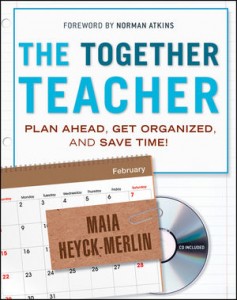Becoming a Together Teacher
The Together Teacher™: Plan Ahead, Get Organized, and Save Time!
by Maia Heyck-Merlin
(Jossey-Bass, 2012 – Learn more)

Author Maia Heyck-Merlin earned my respect and admiration with her humbling introduction to The Together Teacher: Plan Ahead, Get Organized, and Save Time!. In the introduction and throughout the book, Heyck-Merlin describes the “not-together teacher” in whom her readers will surely recognize themselves. However, rather than focusing on the problems with our organizational and time-management systems (or lack thereof), she offers her own comprehensive rules for a system that tackles the never-ending to-do lists and deadlines that haunt many teachers, including me.
Let’s get something straight. I consider myself a pretty organized person. I meet (most) deadlines, reply promptly to work emails (sorry, friends), can find a paperclip, scissors, or yesterday’s graded vocabulary quizzes at my desk within seconds. (Give me 30 to 45 seconds for the quizzes.) However, like most teachers who would benefit from reading this book, I knew that while I have been treading water, I would rather be swimming from one end of the lake to the other. The author’s familiar and encouraging style (along with the features chronicling a real-life teacher at the end of each chapter) make becoming The Together Teacher™ seem attainable. I have never read a book so instantly applicable to my day-to-day life and career aspirations.
 A together book
A together book
As a book on the topic of organization should be, this text is incredibly well-organized with five distinct parts focusing on 1) making work and home priorities; 2) rules and tools of organization; 3) creating weekly plans; 4) organizing email, desks and classrooms and finally; 5) implementation of the systems. The book is part self-help, part manual, so it is best read cover to cover first and then used as a reference. The accompanying CD contains templates and a free Reader’s Guide to record answers to reflection questions posed throughout each chapter.
Each chapter is presented with headings and subheadings that coordinate with the Reader’s Guide so that material is easy-to-digest. The 300+ page text is never dogmatic. Sentences such as “Trust me, some tasks were meant to die” remind the reader to take a deep breath and relax, much like my yoga teachers do when they see a room full of students biting their lips and scrunching their faces in agony.
Heyck-Merlin empowers her readers to own their schedule “rather than reacting to the crisis of the day” and recognize that “being organized is a means to an end — strong student outcomes and more free time.”
You don’t need super powers
From the first chapter, we understand that this is not a book about being a super teacher, but rather about finding the way to accomplish both the tasks we must do (e.g. grading, making phone calls, grocery shopping) and those we want to do (e.g. exercising, spending time with family). The author emphasizes rules such as the necessity of having a portable system and breaking tasks into bite-size pieces. Then, she explains the tools needed to accomplish the goal of “togetherness.”
Throughout the next chapters about calendars, to-do lists, “thought catchers” and meeting and professional development notes, the necessary components of each –including tool and paper and electronic examples — are offered. Heyck-Merlin encourages us to use the format that will work best for us (e.g. smartphone apps, computer programs, paper agendas, wall calendars) and offers numerous recommendations and examples of tools other teachers use. Here again the book empowers; this is not about learning how to implement the author’s organizational system but how to make one that will work for you.
The Weekly Worksheet
Most of us make to-do lists, and while the author offers many ideas for maintaining and prioritizing these lists, these were not the most revolutionary ideas in the book for me personally. The Weekly Worksheet created by reviewing your calendar, to-do list, “thought catchers” and meeting notes is what I believe will most transform my use of time in the coming school year. Two chapters and an appendix are devoted to defining and creating the Weekly Worksheet. It’s these sections I know I’ll be returning to most as I try to implement the book’s strategies.
The fourth section of the book covers physical organization of classroom stations, student materials, and incoming and outgoing papers. The ideas in these chapters are accompanied by photographs when applicable as well as suggestions for where to buy supplies.
Rather than leaving you feeling inspired but overwhelmed, The Together Teacher concludes with a chapter about implementing your system and a sample month-by-month implementation plan. As I write this I’m still enjoying my summer vacation, but have also started getting it “together.” I have begun using a to-do list app on my smartphone, printed the Weekly Worksheet templates from the CD, and planned a trip to my school to reorganize my email inbox and post the author’s email tips next to my computer workstation.
I feel confident that this might be the year that I return graded essays before students forget they wrote them and finish writing progress reports in the daylight hours.
Read another MiddleWeb review of this book
Read a MiddleWeb article by Maia Heyck-Merlin
Beth Fabijanic is a former elementary teacher now working in the middle grades. She teaches English/language arts, drama and yoga to students with language-based learning differences, near Washington, DC. She’s on her way to becoming a “Together Teacher.”



































I really enjoyed this review and plan on introducing this book to my school’s book club. You’ve inspired me. Good luck with the school year!